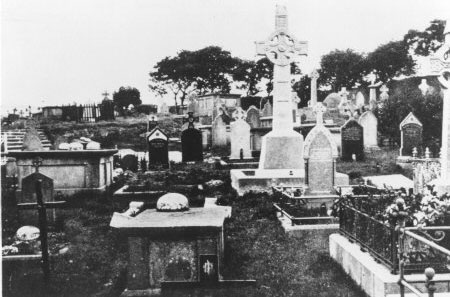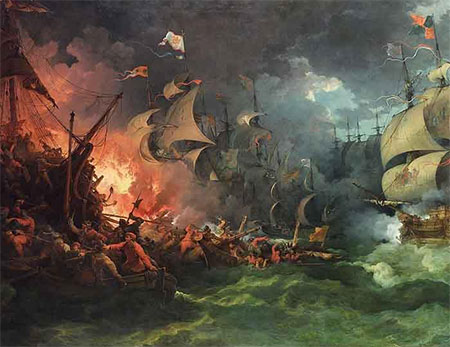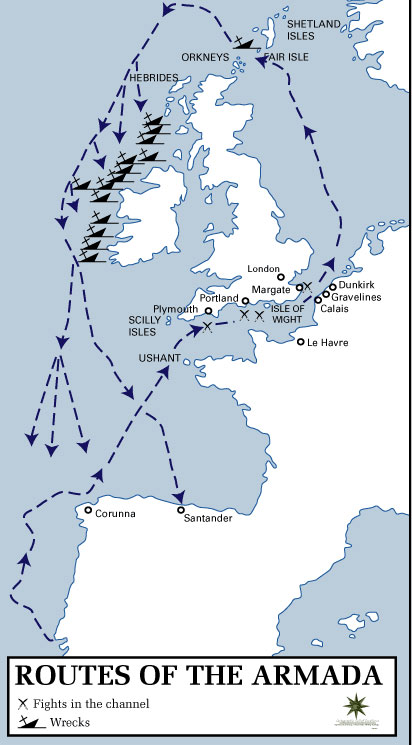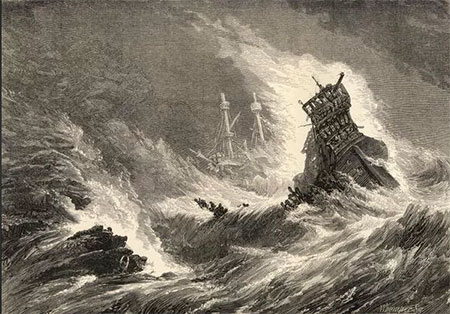
(A photograph, taken in 1901, of Fort Hill Cemetery in County Galway. The cemetery contains Saint Augustin’s Hill and is the resting place of a number of Spanish sailors of the Spanish Armada of 1588. Image courtesy of the Galway Library).
“The Spaniards cast ashore at Galway were doomed to perish; and the Augustinian friars, who served them as chaplains, exhorted them to meet death bravely when they were led out, south of the city, to Saint Augustin’s Hill, then surmounted by a monastery, where they were beheaded. The matrons of Galway piously prepared winding sheets for the corpses, and we have heard that two of the Spanish sailors escaped death by lurking a long time in Galway, and afterwards getting back to their own country.”
– Galway Library
OK- The Derby is over, and despite my frantic cheering, my horse- “Battle of Midway-” could do not better than third. It was fun to get dressed up, and the Mint Julep’s (Woodford Reserve Bourbon is the official whiskey of the Kentucky Derby) were quite tasty.
I woke a little foggy, but that is a hazard of the Gold Cup and Kentucky Derby weekend. I was adrift on topics that would not instantly alienate half of our readers, so while I thought I had subjected you to the worst of my experience with DNA analysis, apparently I lied. There is more of interest- and mystery to be examined. The Socotra Tribe’s roots are distressingly white-bread, with over 95% of the ancestral line being from Northwest Europe, and a majority of that being from the Celtic portions of the British Isles. I was not surprised, though I thought there might be more Scandinavian heritage than the .8% would suggest.
My expectation was that there would have been some comingling between the influx of Viking raiders and traders in the 9th and 10th centuries. After all, we hailed from Galway on the west coast of Ireland before the Diaspora of the 1840s, and most of the Irish coastal cities- like Cork, Dublin, Limerick and Waterford were founded by the visiting Berserkers.
As it turns out, we have only a smidgen of DNA that traveled in the Long Ships to the Emerald Isle. The Vikings left little impact on Ireland other than towns and certain words added to the Irish language, but many Irish taken as slaves inter-married with the Scandinavians, hence forming a close link with the Viking settlements in Iceland.
What did surprise me was the percentage of Iberian blood in my veins- 3.3%.
There were no family stories about any Spanish ancestors, though the more I thought of it, there was a likely explanation for that, since the British rulers of Ireland made a regular practice of beheading any Spanish who survived landfall. The term for the descendants of intermarriage between Spanish and Irish is Black Irish. It is an ambiguous one, sometimes used (mainly outside Ireland) as a reference to a dark-haired phenotype appearing in people of Irish origin. According to enlistment papers, we have tended toward the bluff blonde on Mom’s side of the family, though Dad’s line leans toward the “Tall, dark and handsome” side of the house. Mom used to say that the younger Bill was a dead ringer for Gregory Peck, and I suppose that is how all of us get started in the process of passing the DNA along.
I know, I know. There is research discrediting the impact of the Spanish survivors on the Irish gene pool, but I will go with the DNA evidence and circumstance to narrow the possibilities.
1588 was a big year for England, against all odds. Imperial Spain was at its zenith of prestige and influence. His empire included territories on every continent then known to Europeans, including his namesake, the Philippine Islands. Scholars term the period of Philip’s reign a “Golden Age,” in which the sun never set. Philip II had prevailed in the Low Countries of Europe, and the next item for acquisition was England across the Channel.
The people called him “Filipe the Prudente,” which is not the boldest of nick-names, but for all the patience, he had his eyes set on the conquest of England. The King dug down in the pockets of his breeches and raised a force of 130 ships of the line to conduct the assault. His fleet- the Armada of lore- was anchored near Calais when the out-gunned British attacked.
One of the most effective means of conducting war at sea in those days was use of the Fireship. These were hulls packed with incendiary materials, set alight, and with a skeleton crew to guide itself against the foe. It was a particularly effective weapon against a fleet at anchor, and the Brits achieved tactical surprise as the blazing hulks set fire to the Spanish sails.

In order to escape the flames, many of the Spanish galleons cut their anchor lines, leaving the great iron weights on the sea floor. Most escaped, but with the anchors left behind, they had to stay in motion and underway. To return to Spain, the fleet would have to circumnavigate Scotland and Ireland, and the prevailing winds forced the Armada to flee north. The rocky coasts and the predictably abysmal weather did far more damage to the Armada than the fireships had. As they proceeded south after rounding the northern tip of Scotland at Dunnet Head, the strongest storms in a decade rose, raking the ships with icy breath and tumultuous seas.
Most of the eighty-four remaining ships avoided land, and most of those in turn made it home, although in varying degrees of material readiness. Nearly thirty of them were forced toward the coast of Ireland including several galleons and many merchantmen. The latter had been converted for battle and were leaking heavily, making sail with severely damaged masts and rigging, and of course without their anchors.
One of the ships pressed toward Galway Bay was the Falco Blanco Mediano, a 16-gun, 300-ton ship carrying a crew of 103. Near our ancestral home, Falco Blanco was wrecked on a reef near Freaghillaun in Ballynakill Bay between Clifden and Renvyle. The survivors were looked after by the Connely clan- before they became prisoners of the Crown.

Sir William Fitzwilliam, the Lord Deputy of Ireland, was alarmed, and considered that the Irish might rise if the Spanish landed troops. Not knowing the real state of collapse in the fleet, the harshest punishments were prescribed for the sailors and families like the Connelys.
The survivors of Falco Blanco included several Spanish noblemen, the most renowned of whom was Don Luis de Cordoba, his nephew Don Gonzalo and the captain Pedro de Arechaga. I had no idea we might be associated with the nobility- if anyone had the time for romance, anyway- but as they say, where there is a will, there is a way.
Another ship- the Cocepcion Delcano- had ground ashore at Ards near Carna, not far away and at the head of a natural harbor. As they transited at night in rough weather, the crew saw fires on the shore. Thinking the fires were to guide them in they followed them, little realizing that the bonfires were set by wreckers who deliberately intended to lure the ship to shore and then plunder the contents. Cocepcion Delcano carried two hundred and twenty five souls on board. Captain Juan Delcano went down with the ship. The surviving sailors were greeted in traditional fashion: they were beaten and robbed. Those who survived were brought to Galway, among them being the swaggering Don Diego Sarimento.
In Galway the jails were soon overflowing. Spaniards from wrecks in Mayo had also been sent there, numbering as many as three hundred and fifty. The Lord Deputy had given the order to execute all Spanish captives, regardless of rank and even to use the methods of the Inquisition to get answers, torture. He came all the way on bad Irish road from Athlone to Galway to personally oversee the executions.
At least three hundred Spaniards were taken to a hill at St Augustine’s Monastery (now called Forthill) where the executions would be held. The Augustinians gave the condemned men the last rites and then they were beheaded.
Forty noblemen were set aside for ransom of the nobles. When news of this reached Fitzwilliam he was furious and ordered them to be executed immediately. The order was carried out. Included in the executions were six Dutch boys, who had been on the ships. It is said that two Spaniards were saved and hidden in the city.
This is probably a reference to DeCoroda and his nephew, whose lives were spared. De Corboda had made no secret to his Irish protectors that he was a wealthy man in Spain and doubtless the prospect of a big payday for them was attractive, and probably kept them alive. Nothing survives in the literature I reviewed to outline the dating scene in Galway, so our association with the two noblemen is entirely speculative. They were both repatriated after ransom was paid.
Unsurprisingly, his later writings about his visit to the Emerald Isle reveals he was still quite cross with the Irish.
For my part, the DNA is not prescriptive as much as it is descriptive. But if the DeCordas managed to stay underground for an extended time in Galway, it is at least possible that they are the cause of the Iberian blood in our family veins. It certainly is interesting how that stuff gets around, isn’t it?
Victor DeCordas Socotra does have a certain ring, you know?

Copyright 2017 Vic Socotra
www.vicsocotra.com
